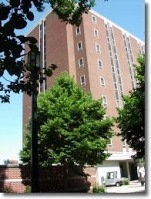Algebra, Geometry and Combinatorics Day (AlGeCom) is a one day,
informal meeting of mathematicians from the
University of Illinois, Purdue University, IUPUI, Loyola University Chicago, and nearby universities, with interests in algebra,
geometry and combinatorics (widely interpreted).
Further details will be posted here as they become available. Or you may
contact the University of Illinois organizers
Hal Schenck and Alexander Yong, or the Purdue organizers
Uli Walther
and Saugata Basu or IUPUI organizer Evgeny Mukhin or the Loyola organizer Peter Tingley.
Date: Nov 9, 2013
Location: Department of Mathematics at Loyola University Chicago
For a map, click here
Afternoon talks will be in Quinlan Life Sciences Center 142. (Building 23 on the campus map).
Poster session and afternoon tea will be in Cuneo Hall 311.
The best place to park is the parking structure P1 on the same map. Usually that costs $7, but it is often
free for specially events on the weekend, so we might get lucky
Speakers and schedule: Coffee and pastries 9-10am
Gregg Musiker (Minnesota) 10-11h Title: Brane Tilings and Cluster Algebras
Abstract. We discuss combinatorial aspects of connections between cluster
algebras and string theory. In particular, physicists such as R. Eager, S.
Franco, A, Hanany, K.D. Kennaway, R.-K. Seong, D. Vegh, B. Wecht, and others
study certain families of quivers and construct duals for them given as
tilings of a torus, known as a brane tiling. In joint work with University
of Minnesota REU students I. Jeong and S. Zhang, we investigated several
such examples, including a six-vertex quiver associated to the dP3 lattice
and periodic quivers coming from Gale-Robinson sequences, and obtain
combinatorial formulas for cluster varialbes with principal coefficients as
subgraphs of these brane tilings. I will not assume prior background on
cluster algebras nor string theory and the talk will include a partial
dictionary between the literature of these two exciting fields. Time
permitting, I will also present recent extensions of this work past the
periodic cases by 2013 REU students M. Leoni, S. Neel, and P. Turner.
Ryan Kinser (Northeastern and Iowa) 11:30h-12:30h
Title: Type A quiver loci and Schubert varieties
Abstract: This talk is based on joint work with Jenna Rajchgot. We describe
a closed immersion from each representation space of a type A quiver with
bipartite (i.e., alternating) orientation to a certain opposite Schubert
cell of a partial flag variety. This is an analogue of a map introduced by
Zelevinsky and later studied by Lakshmibai and Magyar. For type A quivers
of arbitrary orientation, we give the same result up to some factors of
general linear groups.
These identifications allow us to recover results of Bobinski and Zwara;
namely we see that orbit closures of type A quivers are normal,
Cohen-Macaulay, and have rational singularities. We also see that each
representation space of a type A quiver admits a Frobenius splitting for
which all of its orbit closures are compatibly Frobenius split.
Steven Sam (Berkeley) 2:00h-3:00h
Title: Twisted commutative algebras
Abstract: Twisted commutative algebras are an algebraic structure that can be used
to examine sequences of commutative rings with compatible groups of
symmetries, or equivalently (by passing to a limit) for studying
infinite-dimensional commutative rings with large symmetry. They have
appeared in topology and commutative algebra.
The talk will begin with the motivational problem of calculating the
syzygies of determinantal varieties and, more generally, Segre
varieties. Then I will discuss some joint work with Andrew Snowden on
twisted commutative algebras. I will also explain how it appears in
topology through the topic of representation stability and give some
open problems.
Poster session and afternoon tea 3:00h-4:00h
David Speyer (Michigan) 4:15h-5:15h
Title: Schubert problems, stable curves and tableaux combinatorics
Abstract: Given a finite list of points z_i on the projective line, we
can write down a family of enumerative algebraic geometry problems;
the simplest of which is to find rational functions with the z_i as
critical points. The Shapiro-Shapiro conjecture, proved by Mukhin,
Tarasov and Varchenko, states that, if the z_i are all real, then the
solutions to the algebraic geometry problems are all real. I will
describe how to extend this result to when the points collide. This
will give us a collection of coverings of the moduli space of stable
curves. Describing the topology of these coverings recovers standard
manipulations of Young tableaux, and provides new explanations for
them.
--------------------
Poster session exhibits:
Dominic Searles, "Schubert calculus and root-theoretic Young diagrams: planarity and
the adjoint varieties"
Kenneth Barrese, "m-level rook placements"
Samantha Dahlberg, "Pattern Avoidance for Involutions"
Oliver Pechenik, "Homomesy"
Joshua Hallam, "Factorization of the Characteristic Polynomial of a Lattice"
-----------------------------------------------------------------------------------------------------------------
Parking: Lodging: We suggest the Orrington in Evanston, http://www.hotelorrington.com/. The Orrington is also holding 10 rooms at the Loyola rate of $139 a night until Oct 8. Alternatives:
SUPER 8 CHICAGO IL
7300 North Sheridan Road, Chicago, IL 60626 US
(cheapest option, and closest to campus)
The Felix hotel
http://www.hotelfelixchicago.com/
(further away and more expensive, but a good option if some people
want to be closer to downtown.
Banquet: 6pm at "Uncommon Ground" at 1401 West Devon Avenue Chicago IL.
|
|



